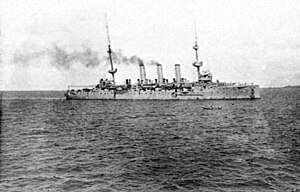 HMS Hyacinth circa. 1915
| |
| History | |
|---|---|
| Name | Hyacinth |
| Builder | London & Glasgow Shipbuilding, Govan |
| Laid down | 21 January 1897 |
| Launched | 27 October 1898 |
| Christened | Mrs. Richmond |
| Completed | 3 September 1900 |
| Decommissioned | August 1919 |
| Fate | Sold for scrap, 11 October 1923 |
| General characteristics | |
| Class and type | Highflyer-class protected cruiser |
| Displacement | 5,650 long tons (5,740 t) |
| Length | |
| Beam | 54 ft (16.5 m) |
| Draught | 21 ft 6 in (6.6 m) |
| Installed power |
|
| Propulsion | 2 × shafts; 2 × triple-expansion steam engines |
| Speed | 20 knots (37 km/h; 23 mph) |
| Complement | 470 |
| Armament |
|
| Armour |
|
HMS Hyacinth was one of three Highflyer-class protected cruisers built for the Royal Navy in the 1890s. Initially assigned to the Channel Fleet, she spent much of her early career as flagship for the East Indies Station. She was reduced to reserve in 1912 after a lengthy refit before becoming the flagship of the Cape of Good Hope Station in 1913. After the beginning of World War I in August 1914, she spent the first few months of the war escorting convoys around South Africa. In early 1915, she was deployed to German East Africa to blockade the German light cruiser SMS Königsberg. She destroyed a German blockade runner attempting to bring supplies through the blockade in April and sank a German merchant vessel in early 1916. Hyacinth remained on the Cape Station for the rest of the war and was paid off in 1919, although she was not sold for scrap until 1923.
Cite error: There are <ref group=Note> tags on this page, but the references will not show without a {{reflist|group=Note}} template (see the help page).